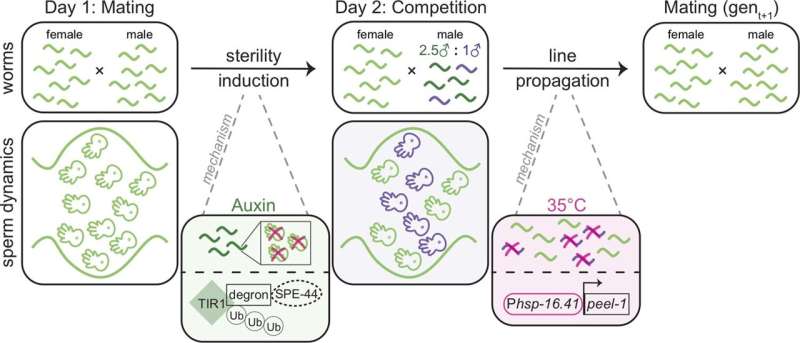Competition among worm sperm speeds up evolution

From elaborate dances to stunning plumage displays to dramatic head-butting, male animals have an array of ways to distinguish themselves from competitors while wooing a potential mate. But it's not their only chance to prove their worthiness.
Sexual selection can take place after mating, too, and new research from UO scientists suggests that it can have a surprisingly large impact on evolution.
Just as a male with a flashier tail might be more likely to win a mate, sperm that are more resilient or stronger swimmers could be more likely to successfully fertilize an egg. Over time, this selection can shape the process of evolution, as genes that make sperm more competitive are preferentially passed on.
In lab experiments that followed Caenorhabditis elegans worms for many generations, sexual selection after sperm are released was a bigger driver of evolutionary change than sexual selection before mating. Researchers in the lab of UO biologist and Provost Patrick Phillips report their findings in a paper published Feb. 14 in PLOS Genetics.
The C. elegans worm is commonly used by researchers as a model organism to study disease and biology in humans.
Thanks to recent advances in gene-editing technology, "we were able to develop a genetic tool that gives us very fine temporal control—we can turn sperm production on and off in worms," said Katja Kasimatis, a postdoctoral researcher at the University of Toronto who led the research as part of her doctoral work at the UO.
That made it possible to tease apart the relative contributions of sexual selection before mating and after insemination.
"It's something we haven't been able to do before," Kasimatis said. "It's really hard to isolate what's happening post-insemination."
She and her colleagues followed worms for 30 generations. (A perk of doing research with worms: The animals go from birth to reproductive age in about 3.5 days.) They introduced new competition at different points, either before or after mating took place, by manipulating when the worms produced sperm.
Increased competition before mating—adding worms with different genetics to the mating pool—decreased selection and slowed the rate of evolutionary change, the team found.
But more competing sperm enhanced selection and increased the rate of evolutionary change. Over 30 generations, males' reproductive success increased by five to sevenfold.
The team also identified about 60 genes that showed rapid change over the course of the experiment. Those genes probably contribute to reproductive success in some way, but more than half of them haven't yet been studied in detail.
"It suggests we have a lot of work to do," Kasimatis said.
Kasimatis's doctoral work at the UO, including the research in this paper, won her the Dobzhansky Award from the Society for the Study of Evolution, a top prize for early-career scientists in the field of evolution.
"Dramatic differences between the sexes have fascinated biologists for hundreds of years," Phillips said. "Katja was able to use genetic engineering to switch sperm competition on and off, use experimental evolution to rigorously test hypotheses that have intrigued the field for a long time, and then use whole-genome DNA sequencing to drill right down to the genes underlying evolutionary change. In many respects, this study represents the culmination of my hopes for what we could accomplish when I began using the worm system for evolutionary studies nearly 30 years ago."
More information: Katja R. Kasimatis et al, Post-insemination selection dominates pre-insemination selection in driving rapid evolution of male competitive ability, PLOS Genetics (2022). DOI: 10.1371/journal.pgen.1010063
Journal information: PLoS Genetics
Provided by University of Oregon




















